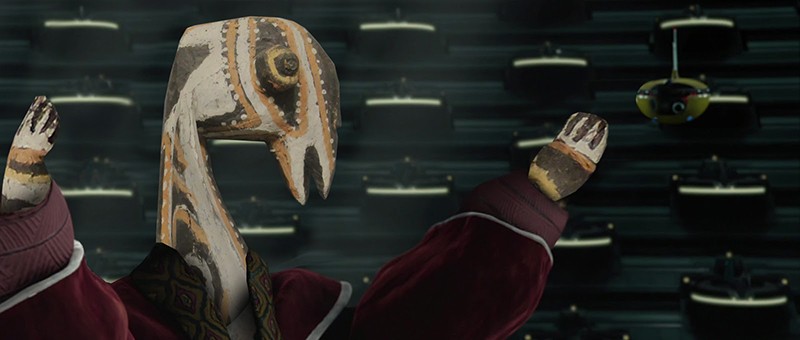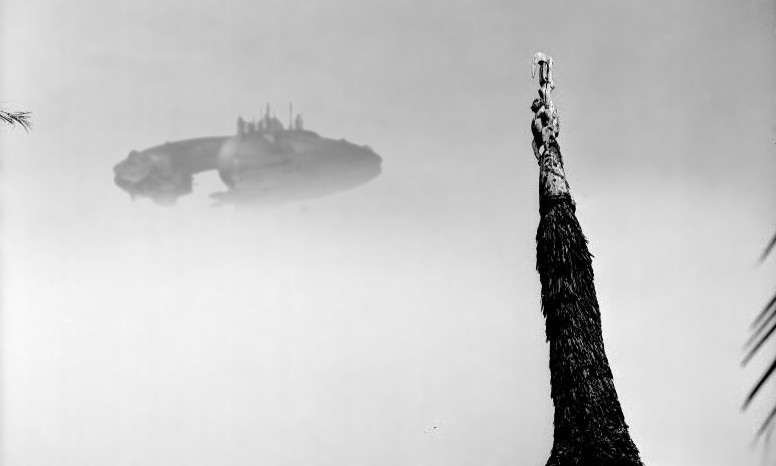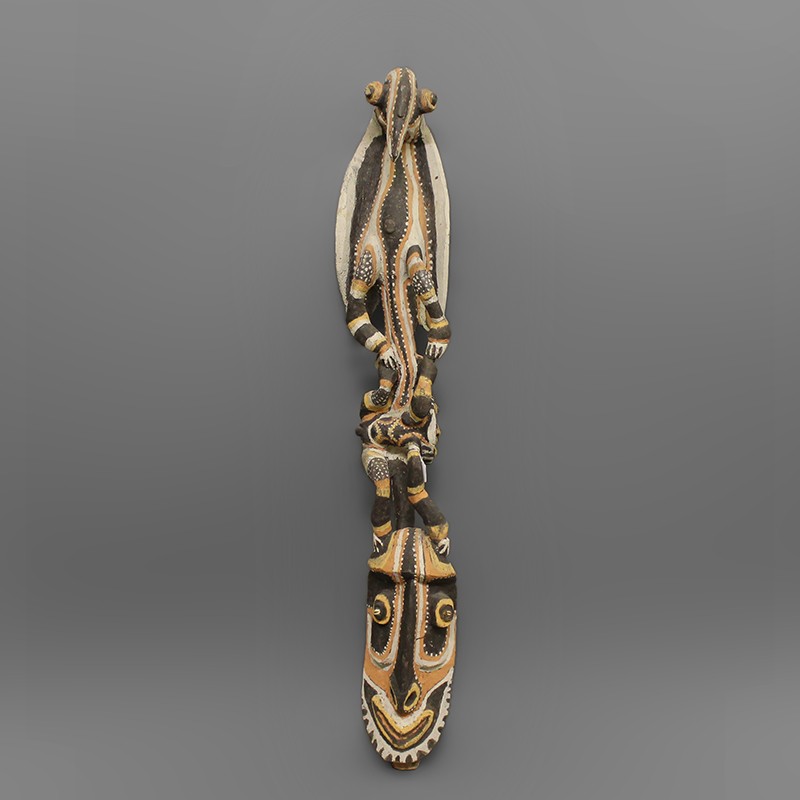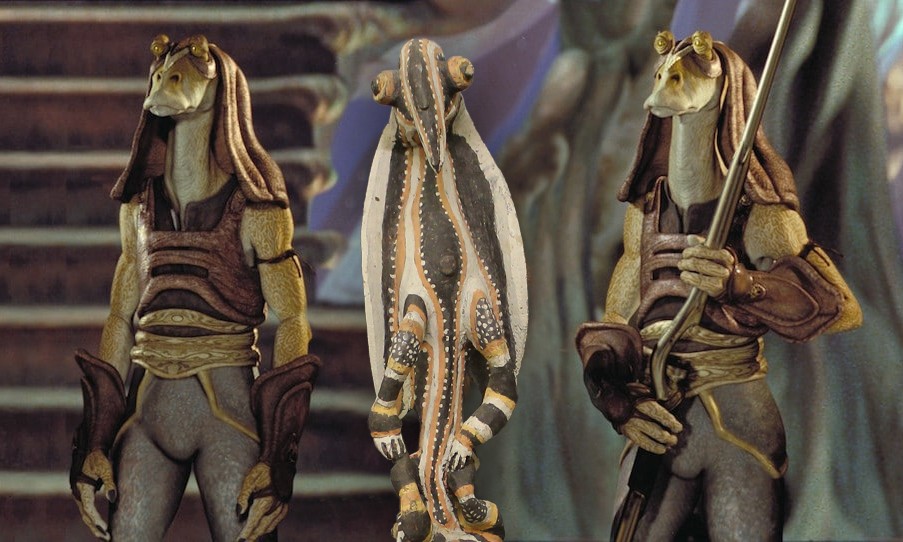© 2023 Kreativa. All rights reserved. Powered by JoomShaper
Much Naboo About Nothing
 |
| Sculpture, late 20th Century Possibly Kwoma culture; Middle Sepik River Region, East Sepik Province, Papua New Guinea, Melanesia Wood, pigment and cowrie shell; 55 in. 98.18.10 Gift of the Jordan Community Trust |
Return of the Fourth
Younglings, padawans and Jedi masters, it is time to force the important issues once more! In previous years the Bowers Blog has celebrated May the Fourth (be with you) by comparing a handcrafted walnut to Chewbacca in Let the Walnut Win: May the 4th at the Bowers and pontificating on a dreadlocked Sukuman sculpture’s similarities to C-3PO in These Are Not the Sculptures You’re Looking For. The subject of today’s post is less-capable of handling human-cyborg relations, but still holds an uncanny likeness to a beloved Star Wars character: Jar Jar Binks. Stow away for a hyperspace leap through the creation and usage of this figure from Papua New Guinea’s Sepik River.
 |
| Artist's rendering of what 98.18.10 might look like addressing the Galactic Senate. |
When is a Gungan not a Gungan? Why, When it’s…
A Jar Jar effigy, most likely not what this sculpture is. The object was donated to the Bowers in 1998, well over a year before George Lucas’ opus Star Wars Episode I: The Phantom Menace was released. Given that this does not depict Naboo’s most notoriously clumsy space alien, what does this carving represent? First off, we need to determine exactly where the object is from, and this already poses a problem. The Sepik attribution is confirmed by a note by the donor, “Sepik river region carved wood mask, surmounted by figure and bird in totemic fashion; black, white, red and orange polychrome finish.” The Sepik, however, is the longest river on New Guinea and numerous groups live along its banks. Furthermore, most Sepik peoples are descended from one common root. Due to this commonality and federated trade along the river, there is a good deal of artistic similarity spanning the length of the Sepik. For example, individual forms within this object, such as the face at the base of the figure, are seen in masks from the Kwoma culture of the Washkuk Mountains as commonly as they are in the art of the Iatmul living directly on the Sepik. This is all to say that identifying this object to a specific culture is difficult.
 |
| Iatmul gable finial with some minor edits © René Gardi, 1956, Archive Museum der Kulturen Basel |
Steady, Steady
The donor’s mention of this object being “totemic” references the stacking of zoological and anthropomorphic figures. Several Sepik cultures create such tableaus, but this specific ordering, a bird sitting on a human figure, is most common among the Iatmul. Here large, carved wooden sculptures regularly take this form perched atop men’s houses as gable finials. The major difference between this Gungan-esque object and Iatmul gable finials—enough of a reason that this figure cannot be attributed to the Iatmul or as having sat atop a haus tambaran—lies in the proportion and pose of this object’s bird. Birds in Sepik art are depicted in several ways. Some masks show predominantly human faces with beaks instead of noses. These are almost always either ancestor figures or the embodiments of spirits. In sculptural carvings such as Iatmul gable finials, mythological eagles tend to be depicted either with wings held up high, serving as a surface for geometric motifs and ornate pigmentation patterns, or sleekly held against their wooden bodies. The wings of this object’s bird figure dangle at its sides like Jar Jar’s floppy ears.
 |
| Front view of 98.18.10, Gift of the Jordan Community Trust |
Yousa Might'n Be Sayin Dat
More stylistic markers seem to indicate that if this object can be attributed to any one culture, it would be the previously mentioned Kwoma. The black, tan, orange and white pigmentation are favorites of their carvers, seen both in the polychrome panels of their ceremonial houses and in their spirit figures, which occasionally do feature men and animals stacked one upon the other. The Kwoma also do use white dot motifs, here employed to frame the sections of black pigment. Again, though, the difficulty in attributing this object to the Kwoma as a result of these indicators is that this color scheme and the use of white dots are also used by others, such as with ngwaalndu ancestral spirit carvings of the Prince Alexander Mountains foothills’ Abelam culture. The best answer to the question of where this object comes from is that its relatively recent inception means that it is an unpackable blend of styles.
 |
| Artist's rendering of what 98.18.10 might look like inconspicuously sandwiched between two Gungan guards. |
Big Da Force
Art objects within Sepik cultures are measured in beauty by their conformity to widely accepted standards for forms. Sepik art tends to be so consistent because carvers are not rewarded for taking artistic license. Independent of how beautiful an object might be to a viewer in subjective terms, mediocre pieces are those which are incongruous with Sepik styles, and scholarship shows that these pieces tend to be the first that are discarded or sold to travelling collectors. What then can we say about an atypical object like this that was likely sold off for being unlike other Sepik artworks? Take the following over-analysis of Star Wars with a grain of salt, but Gungan society is also a rigid one. When we meet Jar Jar Binks in the films he has been expelled from Otoh Gunga for having caused “one, twoey ittle bitty accidenties.” The comparison may seem a stretch, but perhaps aside from sharing floppy ears and eye stalks, Jar Jar and this Sepik figure also share in the common thread of being outcasts? Meesa think so.
Text and images may be under copyright. Please contact Collection Department for permission to use. References are available on request. Information subject to change upon further research.


Comments